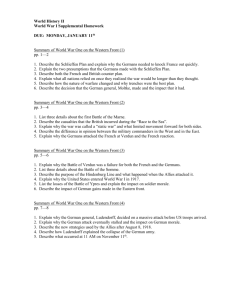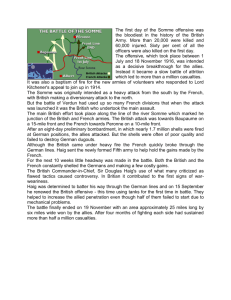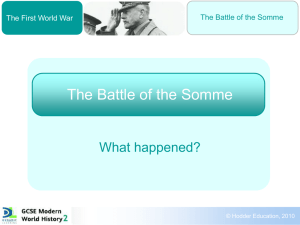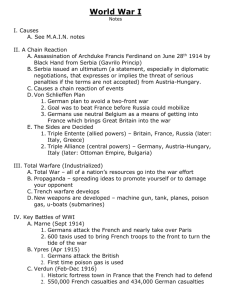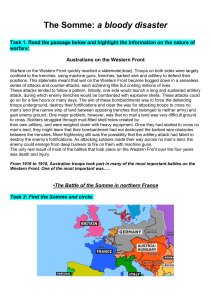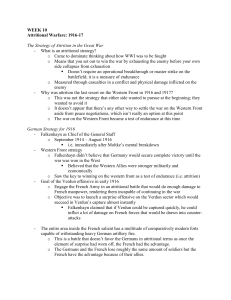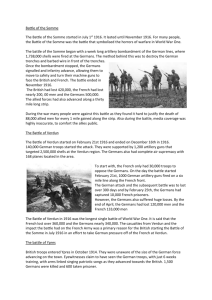The Battle of the Somme
advertisement
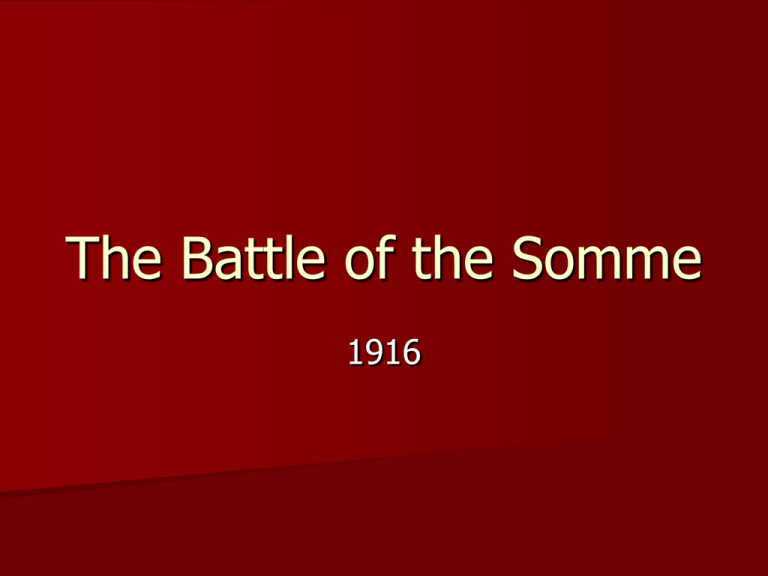
The Battle of the Somme 1916 The Somme July 1, 1916 – November 18, 1916 Attack along a 30 km front 58,000 British casualties on first day One of the bloodiest battles of the war The Allied Plan Joint British-French attack Drain the German reserves Gain territory Majority of fighting to be done by the French Begin on August 1 Commanders French – Joseph Joffre British – Sir Douglas Haig The German Plan Commander – Von Falkenhayn Ordered Verdun offensive Wanted to “Bleed France white” The Allies Attack moved to 1 July Verdun offensive required French troops to meet the German threat British assume the lead at the Somme Intended to draw Germans away from Verdun Haig hoped to force a breakthrough to Cambrai and Douai and split German line Initial Bombardment Shelling of German trenches for 8 days Creeping barrage to precede infantry attack Shelling would continue ahead of the infantry as they took consecutive trenches 1500 British guns and a similar number from the French Underground cables for communication The Attack begins 27 Allied divisions versus 16 German 80% of allies were British and Commonwealth French army will attack to the south Main attack was preceded by a series of 17 mines exploded under German defences Many British shells were defective and did not explode German Defense Germans took refuge in concrete bunkers during shelling Shelling served as a warning of an attack Early Results BEF makes little progress in early fighting Soldiers were heavily laden with equipment and supplies They were slowed down and made easy targets French troops achieved most of their objectives The Germans did not expect them to attack The Battle Continues 11 July 1916 General Rawlinson’s Forces take first line of trenches Germans transfer forces from Verdun to strengthen their line Two Australian divisions take Pozieres Germans re-organize their defenses German First Army led by von Gallwitz Through the Summer Each side believes that a breakthrough is imminent because the other side is tired and weakening Fighting will continue on into the fall A New Weapon 15 September, 1916 Battle of FlersCourcelette First use of tanks 24 of 50 were able to be used Canadians capture Courcelette Scots capture Martinpuich Allied Assaults during the Fall British: Battle of Morval Battle of Thiepval Ridge Transloy Ridge Ancre Heights Battle of the Ancre – Capture fortress Beaumont-Hamel French: Chaulnes East of Morval Final Results British and French gain 12 km of ground British casualties total 420,000 French casualties total 200,000 German casualties estimated at 500,000 Sir Douglas Haig A controversial commander Flawed tactics caused large losses of life Was he forced by the larger circumstances?
